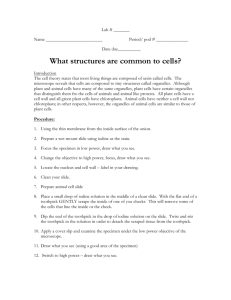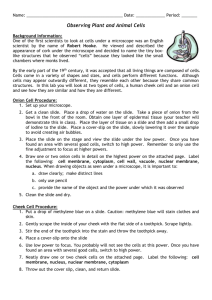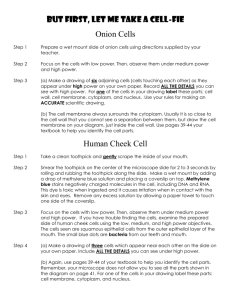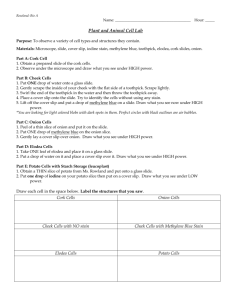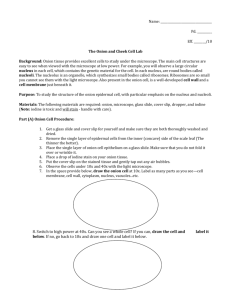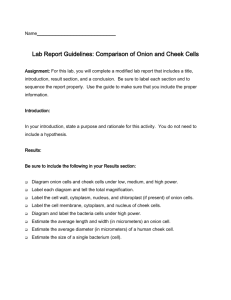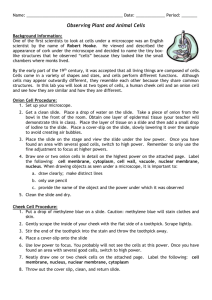Cell Observation Lab - Southington Public Schools
advertisement
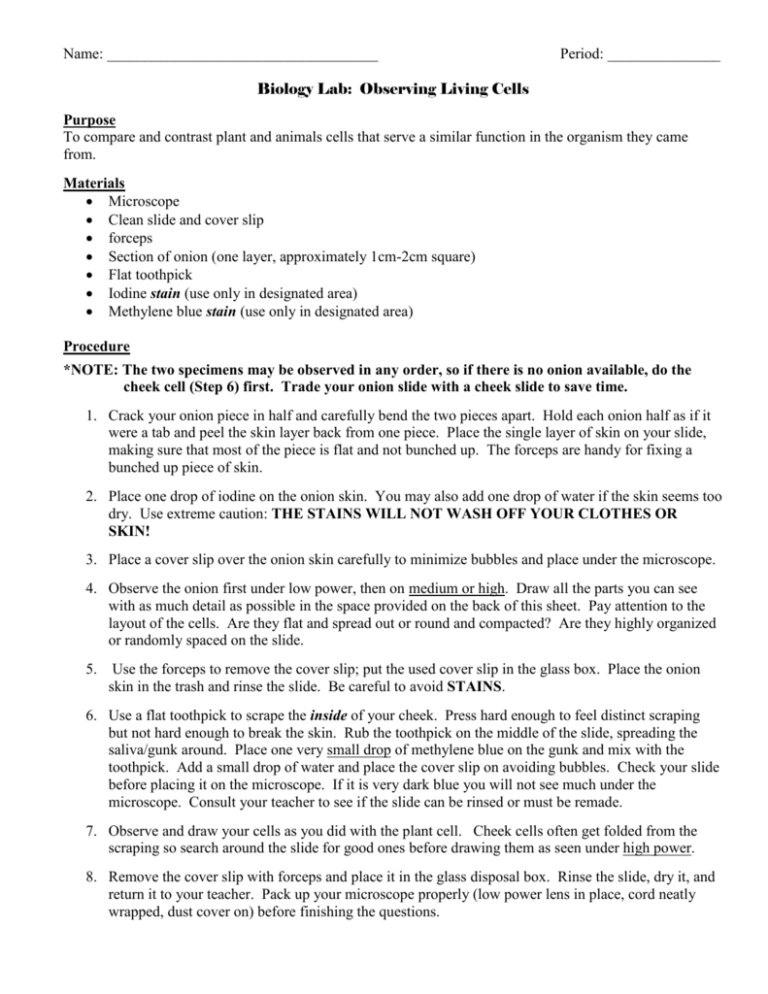
Name: ____________________________________ Period: _______________ Biology Lab: Observing Living Cells Purpose To compare and contrast plant and animals cells that serve a similar function in the organism they came from. Materials Microscope Clean slide and cover slip forceps Section of onion (one layer, approximately 1cm-2cm square) Flat toothpick Iodine stain (use only in designated area) Methylene blue stain (use only in designated area) Procedure *NOTE: The two specimens may be observed in any order, so if there is no onion available, do the cheek cell (Step 6) first. Trade your onion slide with a cheek slide to save time. 1. Crack your onion piece in half and carefully bend the two pieces apart. Hold each onion half as if it were a tab and peel the skin layer back from one piece. Place the single layer of skin on your slide, making sure that most of the piece is flat and not bunched up. The forceps are handy for fixing a bunched up piece of skin. 2. Place one drop of iodine on the onion skin. You may also add one drop of water if the skin seems too dry. Use extreme caution: THE STAINS WILL NOT WASH OFF YOUR CLOTHES OR SKIN! 3. Place a cover slip over the onion skin carefully to minimize bubbles and place under the microscope. 4. Observe the onion first under low power, then on medium or high. Draw all the parts you can see with as much detail as possible in the space provided on the back of this sheet. Pay attention to the layout of the cells. Are they flat and spread out or round and compacted? Are they highly organized or randomly spaced on the slide. 5. Use the forceps to remove the cover slip; put the used cover slip in the glass box. Place the onion skin in the trash and rinse the slide. Be careful to avoid STAINS. 6. Use a flat toothpick to scrape the inside of your cheek. Press hard enough to feel distinct scraping but not hard enough to break the skin. Rub the toothpick on the middle of the slide, spreading the saliva/gunk around. Place one very small drop of methylene blue on the gunk and mix with the toothpick. Add a small drop of water and place the cover slip on avoiding bubbles. Check your slide before placing it on the microscope. If it is very dark blue you will not see much under the microscope. Consult your teacher to see if the slide can be rinsed or must be remade. 7. Observe and draw your cells as you did with the plant cell. Cheek cells often get folded from the scraping so search around the slide for good ones before drawing them as seen under high power. 8. Remove the cover slip with forceps and place it in the glass disposal box. Rinse the slide, dry it, and return it to your teacher. Pack up your microscope properly (low power lens in place, cord neatly wrapped, dust cover on) before finishing the questions. Draw and label the two cells here using as much detail as possible. Label the magnification in the space (eyepiece lens X objective lens…read the magnification labeled on each.) ________ X ________ X Analysis Questions 1. Use your text to list major cell parts that should be the same in both plant and animal cells. Which of these parts were actually observable in both of the cells? List two reasons why other organelles probably were not seen by you. 2. List three things that are clearly noticeable in the text drawings of a plant cell that are not seen in animal cells. Which of these did you observe? 3. An onion is obviously a plant. In the text drawing of a plant cell, you saw that chloroplasts are one of the largest, most noticeable structures in a plant cell. Why are chloroplasts not seen in your onion cells? 4. If you hadn’t broken them apart with the toothpick, you would have observed the cheek cells growing together in a tight, edge-to-edge single layer arrangement. Explain how the similar arrangement of both cheek and onion cells supports the common biological statement “form follows function”. (google this phrase prior to answering if it does not make sense to you)
